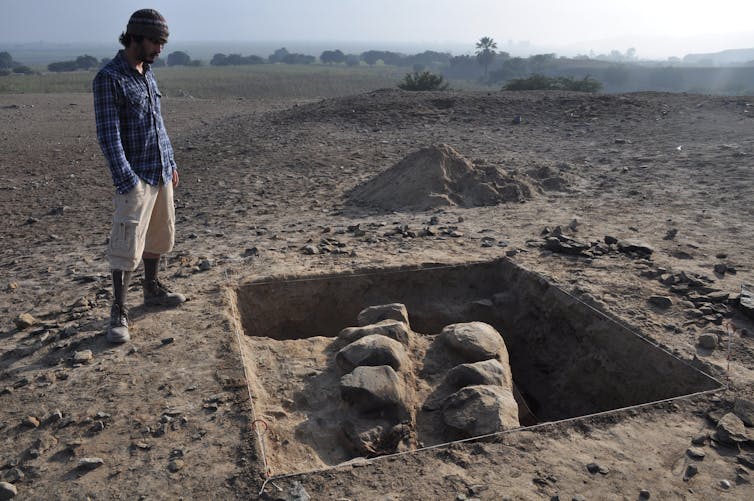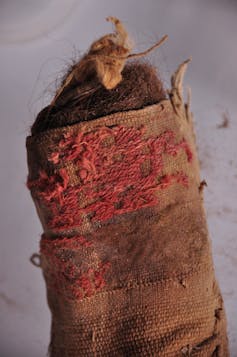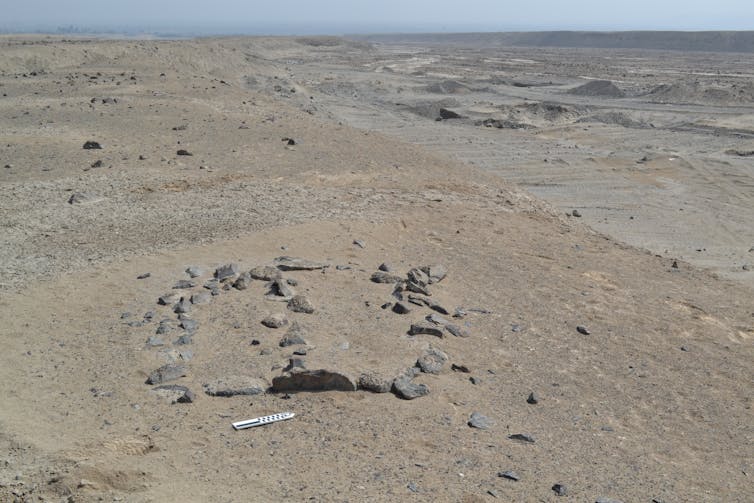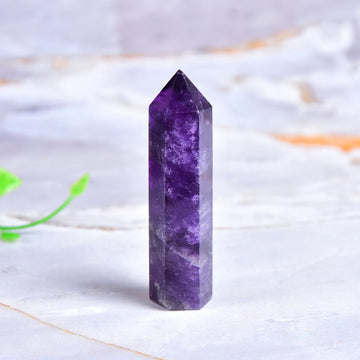“The Epic of Gilgamesh” is one of the earliest texts known in the world. It’s the story of a god-king, Gilgamesh, who ruled the city of Uruk in Mesopotamia in the 3rd millennium B.C. Within its lines, the epic hints at how the ancients viewed the origins of their civilization.
Gilgamesh’s antagonist, Enkidu, is described as a wild man, living with the beasts and eating grasses with the gazelles. But he’s seduced by a beautiful temple priestess who then offers him clothing and food, saying “Enkidu, eat bread, it is the staff of life; drink the wine, it is the custom of the land.” And so Enkidu is transformed from a naked wild beast into a “civilized” man living with other people.
Both bread and wine are products of settled society. They represent the power to control nature and create civilization, converting the wild into the tamed, the raw into the cooked – and their transformation cannot be easily done alone. The very act of transforming the wild into the civilized is a social one, requiring many people to work together.
Over the past few decades, the archaeological theory has shifted toward the idea that civilization arose in different regions around the world thanks to the evolution of cooperation. Archaeologists have discovered that the consumption of food and drink in ritually prescribed times and places — known technically as feasting — is one of the cornerstones of heightened sociality and cooperation throughout human history. My own research in Peru bears this out. The data from my colleagues’ and my work provides yet another detailed case study for theorists to model the evolution of complexity in one of the rare places where a civilization independently developed.
Signs of cooperation in Peru
How does complex society originate out of the hunter-gatherer bands and small settled villages that dominated the globe well into the early Holocene around 9,000 years ago? And once such social organizations develop, what kinds of mechanisms sustain these new societies sufficiently to develop into the Uruks of the ancient world?
Six years ago, after 30 years of research in the Titicaca Basin in the high Andes, my colleague Henry Tantaleán and I started a long-term archaeological research program in the valley of Chincha in the south coast of Peru. Thanks to work by previous archaeologists and our own new data, we have been able to piece together a comprehensive prehistory of the valley beginning several millennia ago.
One significant time period is known as Paracas; it lasted from roughly 800 to 200 B.C. This is the time when the first complex societies developed in the region, the origin of civilization in this part of the ancient world. We documented a massive Paracas presence in the valley, ranging from large pyramid structures to modest villages scattered over the landscape.

Across the hyper-arid pampa lands above the valley, the Paracas peoples built linear geoglyphs: designs etched into the desert landscape that they lined with small field stones. We found five sets of lines that all concentrated on the five major Paracas sites at the edge of the pampa. We also found many small structures built between the lines.
Our research indicated that a number of these small structures and many of the lines pointed to the June solstice sunset. Previous work by our team and others throughout Peru unequivocally indicates that the pre-Columbian peoples of the Andes used the solstices to mark important events.
We concluded that these sites were the endpoints of ritually significant social events that were timed by the solstices and possibly other astronomical phenomena.

Feasting at Paracas
We chose to intensively study one endpoint site, called Cerro del Gentil, to assess its significance in Paracas culture. The site is a large platform mound with three levels. The base level measures 50 by 120 meters at its maximum. Each level contains a sunken patio measuring around 12 meters on a side.

Excavations by Tantaleán and his team in one of these patios yielded a rich trove of artifacts, including textiles, food stuffs, pottery, decorated gourds, stone objects, reeds, miscellaneous objects and human offerings. We found large pottery vessels that held chicha or maize beer, the equivalent to Enkidu’s wine. There was evidence of food preparation as well, though we did not find a resident population. We found large numbers of pottery serving vessels and evidence of termination rituals involving liquid libations poured into the patio at the conclusion of some elaborate feasts.
Cerro del Gentil, in fact, was a classic archaeological example of a very significant feasting place. No one seemed to live at this well-built location year-round, though there was plenty of evidence that from time to time many people were present to eat, drink and even make human sacrifices together, probably at particular special times of the astronomical calendar.
We used the Cerro del Gentil data to test the following hypotheses about how the earliest cooperative human groups came together: Did people start out small, feasting within their local group and then expanding to incorporate more distant groups? Or, did the earliest successful groups develop contacts with distant autonomous groups around a large region?
Our colleague Kelly Knudson from Arizona State University analyzed the strontium ratios in 39 organic objects found in the patios as offerings. The ratio of 87Sr/86Sr in any organic object, including humans, tells us from what geographical zone that object is from. We discovered that objects in the patio were from a very broad range of ecozones all around the south central Andes. Some objects came from as far as the Titicaca Basin 600 kilometers away, others from the south coast 200 or so kilometers distant.

Feasting rituals build a young civilization
This case study demonstrates that the earliest successful complex societies in the south coast of Peru circa 400 B.C. involved a wide catchment of people and objects. At least in Paracas society, the optimal strategy of civilization building involved creating widespread alliances early on and then expanding on this model over centuries. We know this because people in Cerro del Gentil incorporated objects and even people in their offerings from distant areas.
In contrast, at a later ceremonial site where the catchment was quite small, all of the objects and human remains were from the immediate environs, as evidenced by strontium analysis. The Paracas pattern detected at Cerro del Gentil contrasts with a strategy in which people focused on their local group and then grew incrementally over time. My colleagues and I plan to use these sorts of comparative cases to try to understand which strategies work better in which environmental and social contexts.
The evidence from Cerro del Gentil supports the theory I wrote about in my recent book “The Evolution of Human Co-operation” – that cooperation in non-state societies is achieved by “ritualizing” the economy. People construct norms, rituals, and taboos to organize their economic and political life. Far from being quaint and exotic customs of “primitive peoples,” elaborate rules of behavior, encoded in rich ritual practices, are ingenious means of organizing a society where coercion is absent.
![]() Ritual practices reward cooperators and punish cheaters. They, therefore, promote sustained group behavior toward common goals and solve what is famously known as the “collective action problem” in human social life – how do you get everyone to work together toward something that’s in everyone’s long-term self-interest? Feasting is a key component of this kind of sociality and cooperation. Enkidu’s bread and wine are still relevant 5,000 years later.
Ritual practices reward cooperators and punish cheaters. They, therefore, promote sustained group behavior toward common goals and solve what is famously known as the “collective action problem” in human social life – how do you get everyone to work together toward something that’s in everyone’s long-term self-interest? Feasting is a key component of this kind of sociality and cooperation. Enkidu’s bread and wine are still relevant 5,000 years later.
Charles Stanish, Professor of Anthropology, University of South Florida
This article was originally published on The Conversation. It is published here under a Creative Commons License. Read the original article.



































